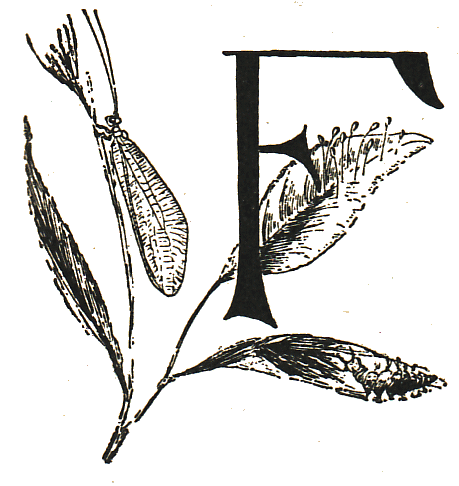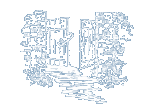|
|
|
|
|
|
|
|
|
|
|
|
|
|
|
|
|
|
|
|
|
|
|
|
|
|
|
|
|
|
|
|
|
|
|
|
|
|
|
|
|
|
|
|
|
|
|
The Mother Lace-wing and the Aphis-lion
|
|
|
|
|
|
|
|
|
|
|
|
|
|
|
|
|
|
|
|
|
|
|
|
|
|
|
|
|
|
|
|
|

|
|
The Mother Lace-Wing and the Aphis-Lion
Teacher's Story
 LITTING leisurely through the air on her green gauze
wings, the lace-wing seems like a filmy leaf, broken
loose and drifting on the breeze. But there is purpose in her flight, and through some instinct she is
enabled to seek out an aphis-ridden plant or tree,
to which she comes as a friend in need. As she
alights upon a leaf, she is scarcely discernible because of the pale green of her delicate body and wings;
however, her great globular eyes that shine like gold
attract the attention of the careful observer. But
though she is so fairy-like in appearance, if you pick
her up, you will be sorry if your sense of smell is keen, for she exhales a
most disagreeable odor when disturbed—a habit which probably protects
her from birds or other creatures which might otherwise eat her.
LITTING leisurely through the air on her green gauze
wings, the lace-wing seems like a filmy leaf, broken
loose and drifting on the breeze. But there is purpose in her flight, and through some instinct she is
enabled to seek out an aphis-ridden plant or tree,
to which she comes as a friend in need. As she
alights upon a leaf, she is scarcely discernible because of the pale green of her delicate body and wings;
however, her great globular eyes that shine like gold
attract the attention of the careful observer. But
though she is so fairy-like in appearance, if you pick
her up, you will be sorry if your sense of smell is keen, for she exhales a
most disagreeable odor when disturbed—a habit which probably protects
her from birds or other creatures which might otherwise eat her.
However, if we watch her we shall see that she is a canny creature
despite her frivolous appearance; her actions are surely peculiar. A drop
of sticky fluid issues from the tip of her body, and she presses it down on
the surface of the leaf; then lifting up her slender abdomen like a distaff,
she spins the drop into a thread a half inch long or more, which the air
soon dries; and this silken thread is stiff enough to sustain an oblong egg,
as large as the point of a pin, which she lays at the very tip of it. This
done she lays another egg in a like manner, and when she is through, the
leaf looks as if it were covered with spore cases of a glittering white mold.
This done she flies off and disports herself in the sunshine, care free, knowing
that she has done all she can for her family.
After a few days the eggs begin to look dark, and then if we examine
them with a lens, we may detect that they contain little doubled-up
creatures. The first we see of the egg inmate as it hatches, is a pair of
jaws thrust through the shell, opening it for a peep-hole; a little later the
owner of the jaws, after resting a while with an eye on the world which he
is so soon to enter, pushes out his head and legs and drags out a tiny, long
body, very callow-looking and clothed in long, soft hairs. At first the
little creature crawls about
his egg-shell, clinging tightly
with all his six claws, as if
fearful of such a dizzy height
above his green floor; then
he squirms around a little and
thrusts out a head inquiringly
while still hanging on "for
dear life." Finally he gains
courage and prospects around
until he discovers his egg
stalk, and then begins a rope
climbing performance, rather
difficult for a little chap not
more than ten minutes old.
He takes a careful hold with
his front claws, the two other
pairs of legs carefully balancing for a second, and then
desperately seizing the stalk
with all his clasping claws,
and with many new grips and panics, he finally achieves the bottom
in safety. As if dazed by his good luck, he stands still for a time,
trying to make up his mind what has happened and what to do next; he
settles the matter by trotting off to make his first breakfast of aphids;
and now we can see that it is a lucky thing for his brothers and sisters,
still unhatched, that they are high above his head and out of reach, for he
might not be discriminating in the matter of his breakfast food, never
having met any of his family before. He is a queer looking little insect,
spindle-shaped and with peculiarly long, sickle-shaped jaws projecting
from his head. Each of these jaws is made up of two pieces joined
length-wise so as to make a hollow tube, which has an opening at the tip of the
jaw, and another one at the base which leads directly to the little lion's
throat. Watch him as he catches an aphid; seizing the stupid little bag
of sap in his great pincers, he lifts it high in the air, as if drinking a
bumper, and sucks its green blood until it shrivels up, kicking a
remonstrating leg to the last. It is my conviction that aphids never realize
when they are being eaten; they simply dimly wonder what is happening.
![[Illustration]](http://www.gatewaytotheclassics.com/bronze/books/comstock/insects/comstock_insects_zpage398.gif)
Aphis-lion, eggs, larva, cocoon and the adult, lace wing.
Comstock's Manual.
|
It takes a great many aphids to keep an aphis-lion nourished until he
gets his growth; he grows like any other insect by shedding his skeleton
skin when it becomes too tight. Finally he doubles up and spins around
himself a cocoon of glistening white silk, leaving it fastened to the leaf;
when it is finished, it looks like a seed pearl, round and polished. I
wish some child would watch an aphis-lion weave its cocoon and tell us
how it is done! After a time, a week or two perhaps, a round little hole is
cut in the cocoon, and there issues from it a lively little green pupa, with
wing pads on its back; but he very soon sheds his pupa skin and issues
as a beautiful lace-wing fly with golden eyes and large, filmy, iridescent,
pale green wings.
Lesson LXXXIX
The Mother Lace-Wing and the Aphis-Lion
Leading thought—The lace-wing fly or golden-eyes, as she is called, is
the mother of the aphis-lion. She lays her eggs on the top of stiff, silken
stalks. The young aphis-lions when hatched, clamber down upon the leaf
and feed upon plant-lice, sucking their blood through their tubular jaws.
Method—Through July and until frost, the aphis-lions may be found
on almost any plant infested with plant-lice; and the lace-wing's eggs or
egg-shells on the long stalks are also readily found. All these may be
brought to the schoolroom. Place the stem of a plant infested with
aphids in a jar of water, and the acts of the aphis-lions as well as the
habits of the aphids may be observed during recess or at other convenient
times, by all the pupils.
Observations—
1. When you see a leaf with some white mold upon it,
examine it with a lens; the mold is likely to be the eggs of the lace-wing.
Is the egg as large as a pin head? What is its shape? What is its color?
How long is the stalk on which it is placed? Of what material do you
think the stalk is made? Why do you suppose the lace-wing mother lays
her eggs on the tips of stalks? Are there any of these eggs near each
other on the leaf?
2. If the egg is not empty, observe through a lens how the young
aphis-lion breaks its egg-shell and climbs down.
3. Watch an aphis-lion among the plant-lice. How does it act?
Do the aphids seem afraid? Does the aphis-lion move rapidly? How
does it act when eating an aphid?
4. What is the general shape of the aphis-lion? Describe the jaws.
Do you think these jaws are used for chewing, or merely as tubes through
which the green blood of the aphids is sucked? Do the aphis-lions ever
attack each other or other insects? How does the aphis-lion differ in
appearance from the ladybird larva?
5. What happens to the aphis-lion after it gets its growth? Describe
its cocoon if you can find one.
6. Describe the little lace-wing fly that comes from the cocoon.
Why is she called golden-eyes? Why lace-wing? Does she fly rapidly?
Do you suppose that if she should lay her eggs flat on a leaf, that the first
aphis-lion that hatched would run about and eat all its little brothers and
sisters which were still in their egg-shells? How do the aphis-lions benefit
our rose bushes and other cultivated plants?
Supplementary reading—"A Tactful Mother" in Ways of the Six-Footed.
|








![[Illustration]](http://www.gatewaytotheclassics.com/bronze/books/comstock/insects/comstock_insects_zpage398.gif)



